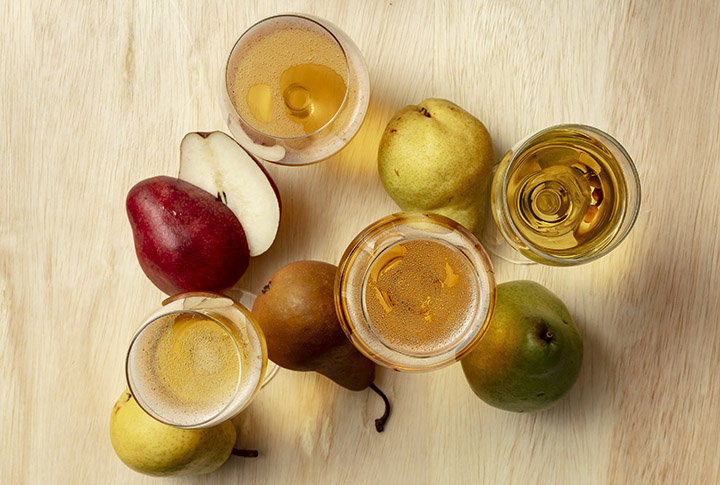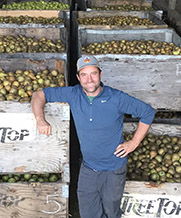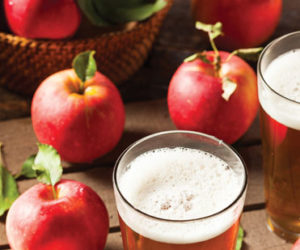Perry is one of the world’s most misunderstood, overlooked, and underrated drinks. Made much in the same way as hard cider or wine, but from pears, it has existed in some form or another for over 2,000 years and has survived extinction— sometimes by a whisker — through the grit and determination and sheer bloody-mindedness of a small group of people who know it to be too great a treasure to lose.

Like wine or cider, its flavors derive from a bewildering host of literally hundreds of varieties of pears, each one with a different aroma, character, and texture. Some of these pears, so-called “perry pears” — particularly those most prominently grown in France, the U.K., and Central Europe — have no other use but the making of this drink. They’re totally inedible — 17th century historians wrote that even pigs wouldn’t touch them — but their drink is sublime. Others are dessert pears such as you might find in cans and pastries. Perhaps even more exciting are the perries made from wild, randomly growing trees, the legacy of lost orchards, and seeds strewn in the droppings of birds and animals.
Again, as with other drinks fermented from fruit, these flavors can be ameliorated and manipulated across a dazzling array of styles according to the methods and intentions of the maker. There are perries made the same way as Champagne, every bit as elegant as their grapey counterpart. Others are big and robust, perhaps aged in oak and bottled still. There are sweet, frothy, gorgeously scented perries made in the classic Normandy style, and there are super fruity, dangerously crushable perries that demand hot days and cold, generous glasses. There are even huge, rich fortified perries, crackling with the warmth of Ports or Sherries.
Whatever the pears, whatever the style, perry offers the patient maker and dedicated drinker a host of possibilities. As aspirational cider has continued its rise around the world, so perry has followed along behind it. But increasingly this much-overlooked drink is gaining its own spotlight and appreciation. On both sides of the Atlantic, and indeed all over the world, from Australia to Japan, from Chile to Canada, the best perries that have ever been made are sitting on shelves right now. If you have not already, there’s never been a better time to discover it and to make your own.
A Brief History
As with all drinks, we’ll never know for certain exactly when the first perry was fermented. Beginning in the wild forests of what is now western China, the pear headed east and west, hybridizing, mutating, and ultimately being specifically cloned and grafted as it went. The first mention of a drink that we would recognize as perry comes in Pliny the Elder’s Natural History of 77 AD, in which he describes “the Falernian pear, so called from the drink it affords.”
For the following millennium it was fairly quiet, appearing mainly in ecclesiastical references from France, where it was even drunk as penance by saints — Saint Redegonde, for instance, retired to a convent where she allegedly drank nothing but water and perry! By the thirteenth century it was achieving prominence in central Europe — for a while it was the favored drink of the Bavarians, even ahead of beer. In the 17th century, when continental wars slowed down supplies of wine to England, perry had a brief heyday alongside cider as “the native wine” of the English.
In the United States, perry achieved surprising popularity, particularly in the Northeast, until an incurable bacteria called fireblight appeared in the Hudson Valley of New York, to which pear trees proved particularly susceptible. Since pear trees on traditional rootstocks take decades to come to fruit-bearing maturity, their devastation by fireblight proved a death knell for American perry, until modern makers once again turned their hands to it.
As recently as 1950, you could have drawn a band across Europe, through the U.K., northern France, Austria, Luxembourg, Switzerland, southern Germany, and conceivably even further, and all along that band perry pear trees were grown by the thousand, and perry was a central part of rural life. But, largely following the mechanization of agriculture, pear trees were cut down to make way mostly for cornfields by the million. Austria’s Mostviertel had a million perry pear trees — today they have somewhere around 200,000. France’s Domfrontais boasted a collective orchard of 1.5 million, but by 1999 only 100,000 remained. In the U.K., numbers would have been very similar, but no one even bothered to keep count. Switzerland, once the heart of the perry world, cut down 11 million fruit trees between 1950–1975 and now I am only aware of two perrymakers in the whole country.
Perry could easily have disappeared entirely; indeed, in some countries it almost did. But thanks to the modern movement around the world, this miraculous drink has been given yet another life.
A Word on the Pears
You can use absolutely any pears in the making of perry, and don’t listen to anyone who tells you otherwise. In the drink’s three modern heartlands — Domfrontais in France’s Normandy, Mostviertel in northern Austria, and the U.K.’s Three Counties of Herefordshire, Worcestershire, and Gloucestershire and just over the Welsh border into Monmouthshire — perry is almost exclusively made with so-called “perry pears.” These varieties are packed with acidity and tannins, like Thorn, Barland, Plant de Blanc, Speckbirne, and Grüne Pichelbirne. You wouldn’t want to eat any of these. Indeed, some are so bitter or sharp that they’ll almost skin the roof of your mouth (trust me, I’ve been there). But these properties can be precisely what lend themselves to the most flavorful and beautifully-structured perries of all. Many of these treasured varieties have now been grafted in American orchards, especially in Washington, Oregon, and New York State, and the comparisons with the flavors of their European equivalents make for fascinating drinking.

Eating pears, generally lower in acidity and entirely without the bitterness of tannin, make a much lighter, subtler perry. All perries are famously hard to make, but without the crutch of lower pH, dessert pear perries can be particularly troublesome. But persevere! Some truly delicious perries around the world, from makers like Oregon’s Blossom Barn, England’s Vagrant and Nightingale, The Netherlands’ Elegast, and Japan’s Kamoshika have used pears like Bartlett, Conference, and Anjou.
The final option is to go wild. America, particularly some of the states already mentioned, has an abundance of randomly grown wilding pear trees, often the legacies of native orchards disrupted or devastated by European settlers, such as those of the Haudenosaunee Confederacy in the area of New York’s Finger Lakes, now harvested by makers like Eve’s. Wild pears offer a whole new world of flavors: Any of these trees has the potential to be the next great perry variety. What’s more, pears that have grown in this way, in U.S. soil, likely have greater inherent resistance to fireblight. As the bacteria continues to decimate pear trees around the world, perries from these varieties may prove to be the most important of all.
Making Perry
The good news, for makers of wine and especially cider, is that if you have an understanding of these drinks, you’re already well equipped to tackle making perry.
The basic premise is the same. Harvest your fruit, crush and press it, ferment it with pitched or ambient yeasts, and package it when ready. And indeed your choice of styles, maturation vessels, and packaging equipment is effectively identical to those you would consider if working with grapes or apples.
There is a “but” (or this section would be very short!). Perry is generally accepted as far more troublesome to make than either cider or wine, which is likely the main reason it doesn’t have the same prominence as those drinks. “If it didn’t make that drink we would stop making perry tomorrow,” Tom Oliver, one of the world’s most renowned perrymakers tells me. “It’s too demanding, it takes too much. Making cider’s a piece of cake compared to making perry, the risks are not there — and then you can’t sell the bloody stuff once you’ve made it! But it’s that drink, honestly. Cider’s great, but if I want to show off to somebody, it’s usually a perry I go for. What a drink.”
So, let’s start from the top with the making of perry and the challenges you’ll face along the way. Though they may sound daunting, they can all be overcome by those who are determined, as home winemakers tend to be.

Harvesting
Depending on the rootstocks, pear trees can grow 60-feet (18-m) tall, with 50-foot (15-m) canopies, and can ripen more than a ton of fruit on a single tree. Sounds great, doesn’t it? Until you consider that you have to get those pears down somehow, and that 60 feet (18 m) is a long way for a piece of fruit to fall undamaged.
Nightmarishly, some varieties won’t drop their entire fruit load, and you may need to take a very long stick and encourage the remaining pears down. (Being hit on the head by falling pears is a perrymaker’s rite of passage). Even worse, some varieties like Yellow Huffcap may begin to rot from the inside out whilst they’re still on the branch.
Pears also have notoriously slim ripeness windows. Think of the pears in your fruit bowl — rock hard for days, until you look away for two minutes and suddenly they’ve turned to mush. You can’t ripen many of them off the tree as you can apples; varieties like Thorn need to be harvested and pressed within two days. Moorcroft, also known in the U.K. as “Stinking Bishop,” can be as little as 24 hours.
Milling (or Crushing) and Pressing
As anyone who has eaten a pear will know, its structure is very different to that of an apple. Milling and pressing overripe pears can be a very messy business. Pears love nothing better than to clog a mill or a press, and since, unlike apples, they don’t float, even washing them is a more tiresome business than it is when making cider.
Nevertheless, despite the clogging and the extra cleaning, any sort of press that can be used for cider can be used for perry. Traditional rack and cloth presses or hydropresses are common amongst small makers, while larger producers might deploy a belt or pneumatic press. We’ve included links at the end of this article for a couple of DIY builds that can help you crush and press your pears (or apples).
Yeasts and Fermentation
Again, yeast selection depends on what you’re attempting to achieve. Amongst small makers in the U.K. and France, native yeasts tend to be commonplace. For larger, more industrial makers, but also amongst many of the makers in Austria who are looking to emulate the style and some of the flavors of still white wine, choosing a particular strain of yeast is more common. Often, though not always, strains of white wine yeast are used for perry production. Cider yeast is also available from some manufacturers in small sachets perfect for 5-gallon (19-L) batches of perry at home, and will work quite well. I’ve even had a perry fermented with kveik, the fast-fermenting Norwegian farmhouse ale yeast that is commonly available at homebrew supply shops.
A note on sulfites is worth making here. Very few varieties of pear — even the perry pears of the U.K. and continental Europe — have pHs as low as those of most apples or grapes. Pear juice is far less stable than apple or grape, and far more susceptible to the impacts of oxygen and biological infection. So much so that I know many makers who take a zero-zero approach with their wines or cider, but will still add a small dose of sulfite to their perry. Those who make stupendous perries without sulfites have my absolute admiration; it is very hard indeed to achieve, and not recommended for a new perrymaker.
Pear juice is also — there’s no other word for it — plain weird. In the first place it contains more sorbitol than grape or apple juice. There’s a long-standing myth that this sorbitol content is at laxative levels. Trust me, if this were the case, I’d be a ghost. The myth almost certainly came about thanks to the historic inclusion of overripe fruit at pressing. Where sorbitol definitely causes headaches is with judging when fermentation is finished. This unfermentable sugar doesn’t sit at the same level each year, so especially for makers looking to bottle pét-nat perries, judging how far along a fermentation is can be trickier than with cider or wine. Even when you think fermentation is complete, give it another week and check again to be sure.
Pear juice also contains a high concentration of a compound called procyanidin, a type of polyphenol, which binds together in all sorts of different and often unsightly ways. I’ve seen two perfectly clear perries which, blended together, became as opaque as milk. I’ve seen sediment thrown that looks — there’s no nice way of saying this — like an alien’s brain. Most frustratingly, I’ve seen perries disgorged to remove this sediment and then gone on to make it again even after filtering. None of this sediment is harmful in any way. But without an exceedingly tight filter, the use of pasteurization, or heavy fining, it may be something you simply need to explain to those you share your perry with. In Austria especially, it is commonplace to mitigate the worst of this by extensive maceration of the pears prior to pressing.
Maturation and Packaging
Whilst it’s by no means universally true, the majority of pears and perries tend to err on the more delicate side compared to ciders or wines. Their flavors can be gentler, more floral, and graced with more elegant nuance. For this reason, most perries tend to be fermented in plastic, stainless steel, or extremely neutral oak.
With that said, varieties that are bolder in character, or makers looking for richer styles such as mistelles or fortified perries, can often deploy oak with delicious results. Mostellos, Austrian fortified perries from Destillerie Farthofer, mature in casks for at least four years. Flakey Bark, from Herefordshire’s Ross-on-Wye, can spend months in active casks and barely change in the intensity of its unique flavor at all. I’ve had perries that aged in wine casks, spirits casks, even casks that held Islay whisky or tequila. And you know what? I loved them all.
Options when it comes to finishing and packaging your perry are identical to those available to the wine or cidermaker. To arrest fermentation prematurely, retaining natural sweetness, perry can be simply pasteurized, or if a more natural style is intended, cold-racked multiple times to remove yeasts, as is common practice in the Domfrontais. Alternatively, the perry can be allowed to ferment to dryness, though care must be taken to ensure any remaining gravity is purely sorbitol, rather than unfermented sugars. (Unfortunately there is no definite way of telling what is sorbitol and what is not with a hydrometer — for most makers this is a matter of patience and experience!) The dry perry can then be backsweetened, if that is the preference, or simply packaged as it is.

Still perry remains a popular option in Austria and the U.K., whether it is bottled, as is the general Austrian preference, or packaged in an old soda keg like the ones homebrewers use or a bag-in-box, as draught perry, as is often found in the U.K. However, it is more common to find perries sparkling. In the Domfrontais this is generally achieved by bottling ‘pét-nat’ – allowing the primary fermentation to finish in its bottle. There are also increasing numbers of traditional method perries, where a secondary fermentation is induced in bottle by the addition of yeast and sugar (around 25 g/L) to a finished perry, in the style of Champagne (Champagne yeast such as EC1118 is the most popular choice here).
If a completely clear perry is desired, maceration prior to pressing as well as heavy fining and filtration are necessary. Because of the biological makeup of pear juice, I have even seen perries reform a sediment after filtration or disgorging. In some instances, the efforts required for absolute clarity in the liquid may come at the cost of considerable amounts of character and flavor. Since perry (other than certain perry pears) has a naturally higher pH than wine or cider, it may also be desirable to adjust acidity and dose with a small amount of sulfite before packaging.
Perry Recipes:
Draught English-Style Still Dry Perry
(1 gallon/3.8 L, scale as needed)
OG = 1.050–1.065* FG = 1.002
ABV = 6.3–8.3%
* The original gravity or °Brix of the juice is dependent on pear varieties, vintage, and growing conditions. Perrymakers in the U.K. generally ferment the juice as is without worrying too much about where in this range it falls.
Ingredients
1 gallon (3.8 L) tannic perry pear juice (or foraged wild seedling pears)
1⁄4 tsp. Fermaid O or other yeast nutrient
Potassium metabisulfite (KMBS) powder
Step by step
Mill and press the pears (if working with raw fruit) and rack into fermentation vessel with 50 mg/L sulfite, sealing with an airlock. (This recipe utilizes wild yeast that comes in on the pears, though you can pitch your favorite white wine yeast to ensure fermentation if you prefer, which should be pitched at this time.) At least 24 hours later add the Fermaid O.
Fermentation with native yeasts will likely take a few months. My preference is to leave it on lees for additional oxygen protection, though this requires a little longer in tank to completely remove reductive aromas. Other makers prefer to rack once or twice, though excess racking will reduce lees protection as well as slowing fermentation. Once fermentation is complete — specific gravity around 1.002, depending on sorbitol levels — rack it off the lees into a separate container and package into bottles or a keg to serve on draft, again with a small dose of sulfite (if desired).
Modern Sparkling Perry
(1 gallon/3.8 L, scale as needed)
OG = 1.068 FG = ~1.010
ABV = ~7.6%
Ingredients
0.9 gallon (3.4 L) pasteurized pear juice
0.1 gallon (380 mL) pasteurized apple juice (the lower pH, the better)
Brown sugar to hit desired original gravity
1⁄4 tsp. Fermaid O or other yeast nutrient
Potassium metabisulfite (KMBS) powder
5 g Lalvin D47 yeast (or similar strain)
1⁄4 tsp. malic acid mixed in half cup of boiled water
30 g corn sugar (if priming)
Step by step
Mix the pear juice, apple juice, malic acid solution, and brown sugar together until the sugar is fully dissolved. Note that the amount of brown sugar needed is dependent on the sugar content of the pear and apple juices used. Start small and measure after stirring the brown sugar until it is dissolved. Once you reach the desired original gravity, add yeast and seal fermentation vessel with airlock. Add yeast nutrient between 24 and 48 hours later.
Ferment until specific gravity reaches about 1.010, then cold crash and rack into a fresh container. Once the perry has dropped clear and fermentation has ceased, stabilize with ~50 mg/L sulfite. Rack into a small keg and force carbonate or stir in priming sugar. You can also stir in the priming sugar (dissolved in a bit of hot water) and then rack to beer bottles and cap to carbonate, which will take a week or two. Keep refrigerated once carbonated.






